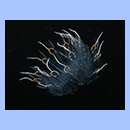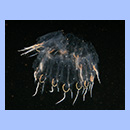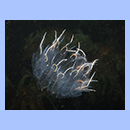- Kingdom: Animalia
- Phylum: Chordata
- Subphylum: Tunicata
- Class: Thaliacea
- Order: Salpida
- Family: Salpidae
- Scientific name: Cyclosalpa bakeri
- Norwegian: -
Characteristics:
C. bakeri has two life stages, a solitary stage and a colonial or aggregate stage. Solitary individuals bud of aggregates in radial whorls. This asexual reproduction contributes to a massive reproduction rate at times. The aggregate form is, as most other salps, hermaphrodites. They start as females and change sex during the colonial phase. Eggs produced by the females are fertilized by other members of the aggregate. There is no larval stage. An embryo inside the females detaches and a new solitary individual is detached from the aggregate, soon ready to bud new colonies again. Each individual form a cylinder, up to 15 cm long, while in the solitary phase. There is an opening in both ends of the cylinder. Propulsion is generated by pumping water through the cylinder. Food is filtered from the passing water very efficiently. It can digest half its mass and grow 25 % in a single day.
Habitat:
It inhabits any depth between 500 meters and the surface. It tends to ascend towards the surface during the night, but usually float with the current.
Distribution:
Well-known from the Pacific and Eastern parts of the Atlantic Ocean. It is most frequent in temperate and cold waters, It has been observed as far north as the Gulf of Alaska in the Pacific and Norway in the North East Atlantic Ocean.


